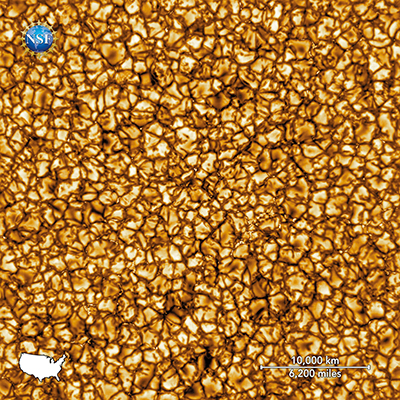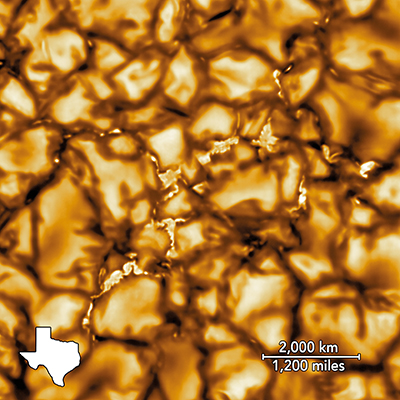The sharpest images of the sun – Balor sCMOS camera from Andor
The highest-resolution images of the sun were taken with Balor sCMOS cameras from Andor at the largest solar telescope of the world. Newly published data of the 4 m Inouye solar telescope (DKIST) on the Haleakala, Hawaii, shows the sun’s surface in unprecedented precision and is the dawn of a new era in high-resolution solar physics. These images and videos show that the sun, which always seems so calm, is much more dynamic than what we have so far suspected. Clearly visible are gigantic convective cell structures, about the size of Texas each, in which plasma as hot as approx. 6000 °C rises to the sun’s surface.
In a film that was taken at a 705 nm wavelength over a time period of 10 minutes, for the very first time structures can be seen that are as small as 30 km.
The video shows the turbulent, “boiling” plasma that covers the entire sun. Cell-like structures – each about the size of Texas – reflect the strong activities that transport heat from the inside of the sun to its surface. Hot plasma rises inside the light centers of the bubbles, cools down and descends underneath the surface at the darker outer areas. This process is called convection. Tiny light spots can be seen in the dark areas – these indicate particularly strong magnetic fields. It is assumed that these magnetic spots transport energy into the outermost region of the sun’s atmosphere – the corona. They could be the reason why the corona is hotter than a million degrees. The movie shows an area of 19.000 x 10.700 km.
© NSO/AURA/NSF
The images were taken with the brand new 16.9 megapixel scientific sCMOS camera from Andor, which has been developed as part of the DKIST telescope project. Balor cameras have a very large dynamic range to capture both dark solar spots and light solar flares in one single image. In addition, the global shutter mode allows every pixel on the array to be exposed at an identical time, which enables the examination of small, rapid movements with extra high precision. With the Balor sCMOS cameras, which are installed on four instruments on the telescope, high-resolution images can be simultaneously captured together with spectral and polarimetric information at a wide variety of wavelengths and atmospheric heights of the sun.
Dr. Aaron Reid, solar physics researcher at the DKIST, explains: “The Balor cameras delivered to the Inouye solar telescope provide a unique solution to a complex problem. The 4 m-telescope requires a very high resolution and at the same time, a fast-enough readout to “freeze” turbulences within the earth’s atmosphere. Only this provides these amazing images. These will finally allow solar physicists to understand the magnetic dynamics that drive the “weather in space” that can cause huge damage on earth and will eventually help make predictions of future events.”
Main causes for the “space weather” are the solar winds and the galactic cosmic radiation. Coronal mass ejections and solar flares can cause damages in the range of trillions of Euros on satellites, GPS and electrical networks. In 2003, airplanes were unable to start or had to be redirected because of a solar storm. In 1989, a heavy solar storm caused a power failure in the entire province of Quebec, Canada and the Toronto stock exchange came to a halt. The ability to prepare for solar storms is of utmost importance for the protection of our technologies and infrastructures.
Professor Mihalis Mathioudakis of the Queen's University in Belfast, who has led the British consortium involved in the development of the Balor sCMOS camera, says: “The images produced by the Inouye Solar Telescope open new horizons in solar physics. Its imaging capability allows us to study the physical processes at work in the sun’s atmosphere at unprecedented levels of detail. We worked hard over the past few years with Belfast-based Andor Technology to develop the cameras that equip the Inouye Solar Telescope and it is highly rewarding to now see this fascinating imaging.”
More information about the Balor, Marana, Zyla and Neo sCMOS cameras from Andor





